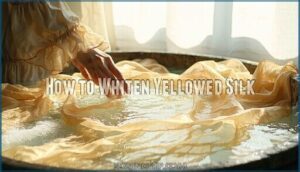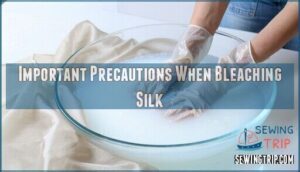This site is supported by our readers. We may earn a commission, at no cost to you, if you purchase through links.

If you’ve stared at a favorite blouse, wondering how to bleach silk without ruining it, you’re not alone. The trick is knowing which methods protect the delicate fibers while lifting stains and restoring brightness.
With the right steps, you can revive silk’s softness and color—no harsh chemicals or guesswork required.
Table Of Contents
Key Takeaways
- Hydrogen peroxide is the safest and most effective bleach for silk, gently lifting stains and restoring brightness without causing yellowing or fiber damage.
- Regular chlorine bleach should never be used on silk because it permanently weakens the fabric and causes irreversible yellowing.
- Always spot test any bleaching solution on a hidden area and use non-metal containers, cool water, and short soak times to prevent damage.
- Factors like sweat, sunlight, improper washing, and poor storage contribute to silk yellowing, so preventive care is just as important as careful bleaching.
Which Bleach is Safe for Silk?
You can’t reach for regular chlorine bleach with silk—it’ll wreck the fibers and leave behind yellow stains.
The good news is that safer alternatives exist, each with its own strengths and uses. Let’s break down which bleaching agents won’t betray your silk.
Why Chlorine Bleach Damages Silk
When chlorine bleach comes into contact with silk, it attacks the protein structure of the fibers themselves, triggering a chemical reaction that weakens the fabric and leaves behind that telltale yellow stain you can’t undo.
This oxidative cleavage breaks down amino acids in the silk, causing irreversible protein damage and fiber degradation. Your fabric loses up to 10% of its strength, and the yellowing only worsens with time—no amount of washing will reverse it.
Oxidative cleavage permanently weakens silk fibers, causing yellowing and up to 10% strength loss that no amount of washing can undo
Hydrogen Peroxide as a Silk Bleach
Hydrogen peroxide stands out as the safest, most effective bleach for silk because it breaks down into water and oxygen—leaving no hazardous residues behind. Unlike chlorine, it preserves fiber strength and whiteness restoration without permanent yellowing. Consequently, hydrogen peroxide is often the preferred bleaching method for delicate fabrics. Here’s why it works:
- Fiber Strength: Causes less than 5% weight loss versus 10% with chlorine bleach
- Bleaching Parameters: Use 3–6% concentration at 30–70°C for 10–30 minutes
- Whiteness Restoration: Increases absorbency and achieves brighter results than hypochlorite
- Environmental Impact: No organochlorines in wastewater; 20% lower energy use
- Safety Aspects: Wear gloves and provide ventilation when bleaching silk with hydrogen peroxide
You’ll achieve professional results while removing stains from silk safely.
Using Distilled White Vinegar and Lemon Juice
If you want a gentler approach than hydrogen peroxide, distilled white vinegar and lemon juice offer natural, acid-based whitening that won’t break down silk’s protein structure. Both work as safe alternatives for bleaching silk and removing stains from silk.
Mix one part distilled white vinegar or lemon juice with four parts cool water—vinegar concentration around 5% and lemon acidity at pH 2-3 work best. Soak duration should stay under ten minutes at room solution temperature for best results.
Silk-Specific Bleach Products
Beyond natural acids, you can find silk-specific bleach products engineered for fiber protection. These formulations use nonchlorine bleach chemistry—often oxygen bleach or hydrogen peroxide blends—designed to minimize protein degradation. Product efficacy varies, so check user reviews for real-world performance. Application methods differ by brand, from pre-soak powders to spray treatments. Cost comparison shows specialty products run higher than DIY alternatives, but they simplify safe bleach for silk when convenience matters. As silk is a delicate protein fiber, it requires careful care during bleaching.
- Read labels carefully for silk compatibility
- Choose oxygen-based or hydrogen peroxide formulas
- Follow manufacturer dilution ratios precisely
- Test on hidden fabric areas first
- Compare prices against DIY hydrogen peroxide methods
What About Oxygen Bleach and Color Removers?
Oxygen bleach and color removers offer a middle ground—gentler than chlorine but stronger than vinegar—when you need more lifting power without damaging silk’s delicate structure.
Oxygen bleach uses sodium percarbonate, a nonchlorine bleach that’s safe for delicate fabrics when used correctly. Rit Color Remover works through reductive bleaching, stripping dye without harsh oxidation.
Both qualify as safe bleach for silk, though you’ll still want to test first and follow dilution instructions closely to avoid overdoing it.
Why Does Silk Turn Yellow?
You might notice your beautiful silk starting to lose its perfect white color over time. Several factors can cause this yellowing, from everyday wear to how you care for the fabric.
Understanding what’s behind the discoloration helps you prevent it and restore your silk when needed.
Effects of Sweat, Sunlight, and Aging
You mightn’t notice at first, but silk fabric discoloration sneaks up over time. Sweat degradation alone reduces tensile strength by up to 20%, while sunlight exposure can slash tyrosine content by nearly 50% after just 10 days. Natural aging adds brittleness and yellowing over decades. Here’s how these three forces cause yellowed silk:
- Sweat degradation introduces salts that trigger protein breakdown and stains
- Sunlight exposure photo-oxidizes amino acids, creating yellow-brown compounds
- Natural aging builds up aldehydes and free fatty acids over years
- Combined impact accelerates color fading by 2–3 times faster than single factors
- Yellowing mechanisms involve carbonyl formation from oxidative reactions
The damage compounds when these factors work together.
Impact of Improper Washing and Drying
Even if you wash silk with care, using the wrong water temperature or harsh agitation can lock in yellowing that no amount of bleaching will reverse. Hot water causes fiber damage and shrinkage risk, while rough treatment weakens the weaving and accelerates color fading.
You’ll also see texture changes, wrinkle formation, and discoloration from detergent residue. Following proper washing instructions protects your silk fabric care investment and preserves its appearance.
Chemical Reactions From Bleaching Agents
Chlorine damage happens fast—it breaks down the peptide bonds in silk protein, triggering tyrosine oxidation that causes permanent yellowing or brown discoloration you can’t reverse.
Oxidative bleaching with hydrogen peroxide is safer, but excess peroxide impact weakens fiber tenacity and increases elongation. Reductive reactions using sulfur-based agents offer only temporary lightening and may cause reoxidation later.
Safe conditions require temperatures below 35°C and pH balance between 6 and 7 to prevent fiber degradation during the chemical process.
Environmental and Storage Factors
Where you store your silk and what it’s exposed to matters just as much as how you wash it. High humidity, direct sunlight, and poor ventilation accelerate yellowing and fiber breakdown. Proper storage conditions protect your silk fabric maintenance efforts:
- Keep silk in cool, dark spaces with low humidity
- Use breathable garment bags, not plastic
- Avoid storing silk garments near heat sources or windows
Water consumption and chemical discharge from textile processing can embed residues that yellow over time, making fabric care important from purchase through storing silk garments.
How to Bleach Silk Safely at Home
Bleaching silk at home doesn’t require fancy equipment or professional know-how. You just need the right materials, a gentle approach, and patience to protect the fabric’s natural fibers.
Here’s what you’ll need and how to safely bleach your silk step by step.
Materials and Tools Needed
Before you start bleaching silk, you’ll need a few simple household items and the right tools to protect your fabric from damage. Gather non-metal bleaching containers (glass or ceramic work best), accurate measuring tools like spoons or cups, and protective gear such as gloves.
Use distilled water for better results, and have drying racks ready for air-drying. These materials for bleaching guarantee safe methods for silk bleaching while providing alternatives to chlorine bleach for your home bleaching process.
Preparing Your Silk Fabric
Once you’ve got your tools ready, the next step is to get your silk fabric prepared so it’s clean and ready to accept the bleaching treatment.
Here’s how to prepare silk garments properly:
- Check the fiber content and fabric weight to understand how your silk will react to bleaching solutions
- Examine the weave structure and surface texture for any irregularities that might affect colorfastness
- Wash the silk fabric gently in cool water to remove dirt, oils, and residues before starting
This preparation guarantees better, more even results when testing for colorfastness.
Performing a Spot Test for Safety
Testing on a hidden spot is how you make sure your silk won’t react badly to the bleaching solution before you treat the whole piece. Pick a small area—like an inner seam—apply your diluted solution, then watch for color change or texture shifts.
Here’s a quick table to guide your spot test:
| Test Area | Solution Concentration | Time Sensitivity |
|---|---|---|
| Inner seam | 1:10 dilution | 5 minutes |
| Hem corner | 1:20 dilution | 10 minutes |
| Under collar | 1:15 dilution | 7 minutes |
Step-by-Step Bleaching Instructions
Start by preparing your bleaching solution—use hydrogen peroxide, distilled white vinegar, or lemon juice, mixed with water. Submerge your silk fully, keeping an eye on immersion time: five to ten minutes is enough. Stir gently, ensuring even exposure. Remember, spot testing first is key.
Once time’s up, move directly to rinsing thoroughly—don’t let the fabric linger.
Proper Rinsing and Drying Methods
After you’ve finished soaking, rinsing your silk the right way makes all the difference in keeping its color and texture intact. Use cold running water or lukewarm water to flush out stains and bleaching residue. Gently squeeze, never wring.
Towel drying helps absorb moisture. Hang silk in a shady Drying Location with good Air Circulation to prevent damage.
How to Whiten Yellowed Silk
Yellowed silk can be brought back to life with the right methods and a gentle touch. You’ve got a few safe options to choose from, depending on what you have on hand and what you’re working with.
Here’s how you can restore your silk to a fresher, brighter look.
Restoring Whiteness With Hydrogen Peroxide
Think of hydrogen peroxide as your secret weapon for bringing tired, yellowed silk back to its natural brightness without harsh chemicals. To bleach silk safely, remember:
- Use a low Peroxide Concentration to protect Fiber Integrity.
- Control Temperature Effects and pH Levels for even whitening.
- Limit Bleaching Time to avoid damage.
Follow your silk fabric care guide for best stain removal.
Using Vinegar or Lemon Juice Solutions
When you reach for vinegar or lemon juice, you’re choosing gentle, natural ways to lift stains and brighten silk without risking damage. Adjust vinegar concentration or lemon acidity, mix with cool water, and soak your silk for a short duration.
Keep solution temperature low and monitor pH balance. Bleaching silk with vinegar or lemon juice helps preserve the fabric’s delicate sheen.
Special Tips for Silk Sheets and Pillowcases
Think about your nighttime skincare routine—any residue can transfer to silk sheets and pillowcases, causing stains or yellowing. Choose high thread count and tight weave type for durability, and always treat silk stains promptly.
If you have allergy concerns, rinse thoroughly after bleaching silk safely. This helps with stain prevention and keeps your silk bedding luxuriously fresh.
Removing Stains and Lightening Silk
Stains and discoloration can make silk lose its charm, but you have options. With the right approach, you can tackle tough spots and lighten silk safely.
Here’s what you need to know before you get started.
How to Get Oil Out of Silk
Oil stains on silk can feel like a stubborn shadow, but with the right approach, you can lift them without harming the delicate fabric.
Start by blotting the oil stain gently—never rub. Sprinkle cornstarch or talcum powder to absorb grease stains. After a few hours, brush off the powder, then wash with gentle detergents.
For tough oil stain types, consider professional cleaning.
Treating Water and Sweat Stains
Sweat and water stains can leave silk looking tired, but with the right care, you can revive its natural glow. For effective Sweat Stain Removal and Water Stain Prevention, follow these steps:
- Blot stains quickly—timing matters.
- Use cool water for Delicate Fabric Care.
- Apply diluted vinegar for stain removal.
- Rinse silk thoroughly to prevent stain color changes.
Lightening Silk Before Dyeing
Start by soaking your silk in a diluted hydrogen peroxide solution—this helps with Dyeing Preparation and Shade Adjustment. Use cool water and gentle agitation to protect Fiber Integrity.
Rinse thoroughly for Color Uniformity. Always spot test first, since lightening silk fabrics can affect Dye Compatibility.
Bleaching silk this way gives you a fresh canvas for even, vibrant dyeing.
Important Precautions When Bleaching Silk
Bleaching silk calls for a careful approach if you want to protect its beauty and strength. There are a few key things you should keep in mind before you start.
Let’s look at the most important precautions to follow.
Avoiding Damage From Metal Pots and Tools
Pot Material Matters when bleaching silk. Reactive metals like aluminum and iron can cause Rust Staining or Discoloration Risks—think orange streaks or dull patches.
To prevent silk damage, always choose Stainless steel or enamel pots. Alternative Containers, such as glass or plastic basins, work well too. That simple switch keeps your fabric’s sheen safe and your results consistent.
Ensuring Proper Ventilation and Safety
Open a window or set up a fan—fume inhalation is no joke, even with safe alternatives. Wear gloves for skin protection and goggles for eye safety. Keep first aid supplies handy, just in case.
Dispose of leftover bleach bath responsibly. Following chemical safety guidelines prevents silk damage and keeps you safe throughout the process.
Environmental Impact and Safer Alternatives
You’ve protected yourself—now let’s protect the planet. Water pollution and ecosystem risks from silk bleaching are real, raising the carbon footprint. Want gentle whitening? Try hydrogen peroxide or plant-based whiteners at home. Looking for safer bleaching? These options:
- Reduce chemical runoff
- Lower energy use
- Support natural fibers
- Encourage smart consumer actions
Small choices make a lasting difference.
What to Do if You Accidentally Over-Bleach Silk
Start with a Fiber Damage Assessment—check for brittleness or thinning.
For mild cases, try Color Restoration Techniques: soak silk in diluted vinegar or a gentle conditioner to restore softness. If the fabric feels weak, look into Strength Recovery Methods or seek Professional Silk Repair.
Learn from this for Future Prevention Tips—always test bleach on a hidden patch first.
Frequently Asked Questions (FAQs)
How long should the fabric be soaked in the peroxide bath?
Like a chef timing a soufflé, you want the ideal soak time for bleaching silk at home—usually 5–10 minutes in hydrogen peroxide.
Peroxide concentration, temperature effects, silk type, and agitation impact all influence results.
Can I use a different detergent instead of synthrapol?
You can use gentle detergents in place of synthrapol. Look for options with neutral pH levels to protect silk fibers.
Mild dish soap or baby shampoo work well, supporting stain removal and safe washing techniques for delicate fabrics.
Is it necessary to use a stockpot or can I use a regular pot?
“Measure twice, cut once”—that wisdom holds true even here. The pot material matters; aluminum and iron can cause fiber staining. Pick a non-reactive, roomy pot for even heat distribution. Stock pots work, but alternative containers suit smaller silk pieces.
Can I bleach silk with a higher concentration of hydrogen peroxide?
Going above the recommended dilution for hydrogen peroxide, such as jumping from 3 to 10 percent, sharply raises Peroxide Concentration Risks.
Fiber Damage Thresholds drop, Bleaching Time Impact increases, and Post-Bleach Treatment becomes critical to avoid ruining silk.
Will the fabric become weaker or softer after bleaching?
Yes, bleaching silk fabric—even gently—can weaken fiber strength, making it softer and more delicate. High bleach concentration, long treatment duration, or repeated bleaching accelerate this effect.
Balancing fabric lightening with preserving fiber structure is key to preventing silk damage.
Can silk be bleached multiple times safely?
You can bleach silk more than once, but repeated risks like fiber degradation and bleach accumulation add up. Safe intervals and gentle methods are key.
Long-term effects may include fabric lightening and weakening, so prevent silk damage whenever possible.
Does bleaching silk affect its softness or sheen?
Think of silk’s legendary glow—bleaching silk, especially with strong bleach concentration, can cause softness alteration and sheen reduction.
Over time, fiber damage may dull the surface, making sheen preservation and fabric restoration harder with repeated treatments.
How long does the bleaching effect last on silk?
The bleach effect duration on silk depends on the bleach type, long-term care, and colorfastness of the fabric.
Over time, exposure to light, sweat, and improper washing leads to re-yellowing, gradually reversing fabric restoration and starting the color fading process.
Can printed or embroidered silk be bleached?
Bleach before you leap!" Printed and embroidered silk garments face real risks—print bleachability is poor, and embroidery damage or color bleeding turns pattern fading into a headache. Always spot test to check thread stability before bleaching silk fabric.
Is professional silk bleaching recommended for vintage fabrics?
Entrusting vintage fabrics to professional silk bleaching makes sense when you weigh vintage fabric risks against inexpert treatment.
Professional expertise is needed for rare or irreplaceable silk, especially where cost-benefit analysis, insurance liability issues, or alternative restoration methods factor in.
Conclusion
Like rewinding a cassette tape, understanding how to bleach silk lets you bring fabric back to its brightest moment. Each careful step repairs what time and sunlight have dulled, giving old favorites a second act without risk.
With the right knowledge, you can treat stains or yellowing confidently, keeping silk’s beauty intact. Approach each treatment as an act of preservation, not just cleaning.
Silk rewards patience—and now, you know exactly how to treat it right.















